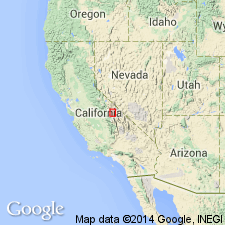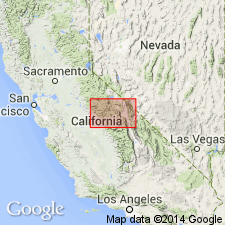
- Usage in publication:
-
- Inconsolable Granodiorite*
- Modifications:
-
- Named
- Dominant lithology:
-
- Granodiorite
- AAPG geologic province:
-
- Sierra Nevada province
Summary:
Named for Inconsolable Range. Type locality: Inconsolable Range [37 deg 08'N, 118 deg 32'W, Mount Goddard 15' quad, Inyo Co, CA]. Crops out in Sierra Divide from Middle Palisade to Mount Agassiz and extends N in Inconsolable Range to latitude of Chocolate Peak. Main mass is elongate in NW direction and has area of little more than 12.5 sq mi. Is medium grained and medium gray. Intruded by Lamarck Granodiorite (new) and by quartz monzonite similar to Cathedral Peak Granite. Relations with Tinemaha Granodiorite (new) not determined. Is Cretaceous age.
Source: GNU records (USGS DDS-6; Menlo GNULEX).

- Usage in publication:
-
- Inconsolable Granodiorite*
- Modifications:
-
- Geochronologic dating
- Age modified
- AAPG geologic province:
-
- Sierra Nevada province
Summary:
K-Ar ages on hornblende and biotite of Inconsolable Granodiorite yielded 98 and 87 Ma. Interpretation of the isotopic ages is subject to re-evaluation as more data are made available. "Older granitic rocks, in particular the Tinemaha and Inconsolable Granodiorites, should be referred to the 'Jurassic or Cretaceous'." p.164.
Source: GNU records (USGS DDS-6; Menlo GNULEX).

- Usage in publication:
-
- Inconsolable Quartz Monzodiorite*
- Modifications:
-
- Redescribed
- Age modified
- AAPG geologic province:
-
- Sierra Nevada province
Summary:
Inconsolable Granodiorite (Bateman, 1961) renamed Inconsolable Quartz Monzodiorite to conform to changes in classification system (Streckeisen, 1973). Typical rock is medium dark gray and has average grain size of 2mm. Color results partly from prevalent gray to dark-grayish red color of feldspar. Contains abundant mafic inclusions. Is intruded by Lamarck Granodiorite and leucogranite of Rawson Creek. Is in contact with Tinemaha Granodiorite. Inconsolable Quartz Monzodiorite has Rb-Sr whole rock age of 105 +/-11 Ma (R.W. Kistler, unpub. data, 1983). Age changed from Jurassic or Cretaceous to: Early Cretaceous. [no longer included in Middle Jurassic Palisade Crest Intrusive Suite].
Source: GNU records (USGS DDS-6; Menlo GNULEX).
For more information, please contact Nancy Stamm, Geologic Names Committee Secretary.
Asterisk (*) indicates published by U.S. Geological Survey authors.
"No current usage" (†) implies that a name has been abandoned or has fallen into disuse. Former usage and, if known, replacement name given in parentheses ( ).
Slash (/) indicates name conflicts with nomenclatural guidelines (CSN, 1933; ACSN, 1961, 1970; NACSN, 1983, 2005, 2021). May be explained within brackets ([ ]).

